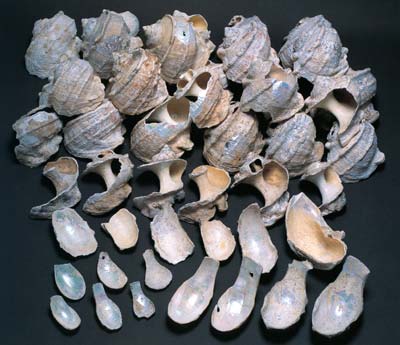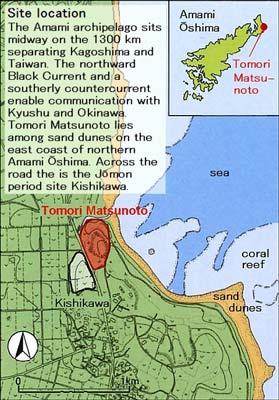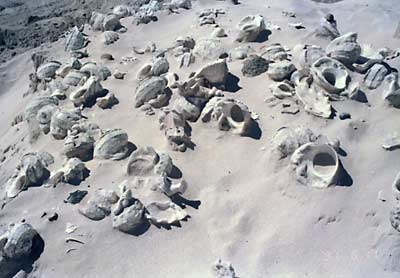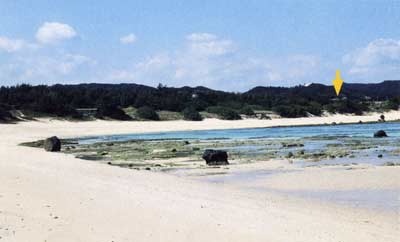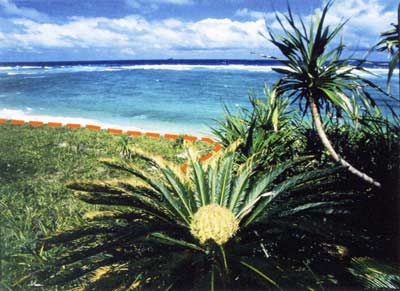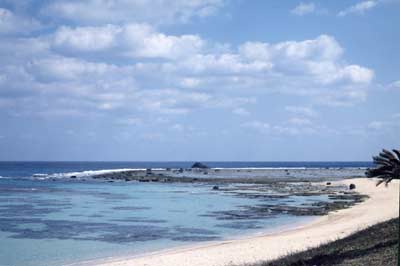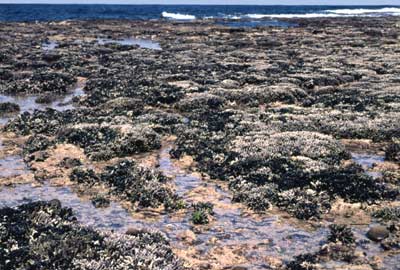Tomori Matsunoto: Green turban shells that were taken to Yamato, to China. Bewitching shells emerge from the white dunes.



Shell spoon (vessel made of shell) Heian period, ca. ninth century. Diameter: 21 cm; height: 12 cm. A hole is made on one side of the round, back side of the shell, and a portion is cut out. The calcified outer layer is polished down to give a glossy greenish surface. The handle portion is narrow with a constricted neck, and may or may not have a hole. The entire item is polished to give a bewitching rainbow-like brilliance. |

| Kaneku, Susen Tō, incised line, and plain pottery styles Kofun-Heian periods, sixth to tenth centuries. No. 7: Kaneku style vase; rim diameter: 22.5 cm, height: 31.5 cm. Kaneku style pottery dates from the eighth to about the tenth centuries, and is the type for the period of the site introduced here. Vessel shapes are vases and cooking pots, with the latter being overwhelmingly common. Cooking pots have rims that flare slightly outward, and nearly always have clay bands applied at the necks near the rim, which are given a notched pattern. Bases come to a flattened point, and the underside bears leaf impressions. Similar pottery has been found at the Yōmisaki, Aragō, Nagahama Kaneku, and Kominato Fuwaganeku sites. 1, 6 Incised line pottery (seventh century) 2, 3, 5, 7-9 Kaneku pottery (eighth-tenth centuries) 4 Susen Tō pottery (sixth-eighth centuries) 10 Plain pottery (seventh-eighth centuries) |
(Bunkachō [Agency for Cultural Affairs], ed., Asahi Shimbunsha, 2008).
Photos courtesy of Amami municipal board of education,
and Imperial Household Agency.
Tomori Matsunoto Site, Amami City, Kagoshima Prefecture
Large quantities of green turban shells recovered from a sand dune
Tomori Matsunoto is an eighth-tenth century site in a region of sand dunes on the east coast of the northern part of Amami Ōshima island. Sand dune sites make up more than sixty percent of the total on Amami Ōshima, and the eastern coastal strip which includes Tomori Matsunoto has concentrations of Jōmon sites from the Early through the Late Jōmon periods on the inland side of the coastal road, and sites from the Yayoi through the early historic periods on the seaward side.
During work to quarry sand, the site was discovered with large amounts of artifacts scattered through the cultural layer. Black strata can be seen between deposits of white sand (see photo); these bear the traces of human activity.
Large univalve shells such as the great green turban (Turbo marmoratus) and top shells (Trochus niloticus) were recovered in great quantities. In addition, imported items such as bronze and iron implements, and Haji ware pottery were recovered, along with Kaneku style pottery made on Amami, plus items made from turban shell (shell spoons), shell pendants, etc.
As it is rare for turban shell to be found in such great amounts, it is thought that in addition to gathering the shell from beyond the coral reef which spreads out from the shore in front of the site, turban shell was perhaps brought in from the outside as well. While some of this may have been used for food, as the process of manufacture of shell spoons can be traced out at the site, it is understood that these items were made here. Further, from a comparison of the sizes of recovered turban shell, it appears possible that small and medium items were used for food, while the large ones were used separately for shell spoon making.
Why turban shell?
What was the need for so much turban shell?
Mother-of-pearl inlay work is thought to have been transmitted to Japan from Tang China in the eighth century. Turban shell was used as a material in the process.
Around the eighth and ninth centuries, demand for mother-of-pearl inlay increased in Japan and China, and it is thought that turban shell was transported from sites like Tomori Matsunoto. As evidenced by the shell inlay work surviving among the treasures of the Shōsōin and the Konjikidō at Hiraizumi in northern Honshu, the craft was highly prized by the Yamato court of the Nara and Heian periods. The Heian aristocracy can also be seen, in written records (such as Makura no sōshi, Utsuho monogatari, Gōke shidai), holding banquets at which shell spoons were used. Possibly these items were made of turban shell.
Relations of Amami Ōshima with Yamato and China?
About forty sites of this age lie on coastal sand dunes, centered on Amami Ōshima and Tokunoshima and extending to the middle of the Okinawan archipelago. At Amami no agriculture was practiced as yet, and it is thought that a hunting-gathering livelihood was followed on a small scale in the coastal dunes with seasonal migrations.
Items brought from Yamato such as Haji and Sue wares, soapstone and iron articles, and glass beads, along with Kaiyuan Tongbao coins from China, are recovered from these sites together with articles made from shell, and it is thought that trade or exchange of these goods, along with information, was conducted with Yamato and China.
Situated between Yamato and Ryūkyū, the diverse cultural information obtained through inter-island exchange was probably transmitted to both the southward advancing Yamato and the northward expanding Ryūkyū. From the results of these investigations it may be possible to glimpse the outlines of Amami culture being nurtured by the natural setting out of the cultures of both regions.
(Nakayama Kiyomi)